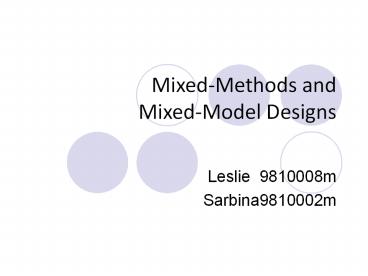Mixed-Methods and Mixed-Model Designs - PowerPoint PPT Presentation
Title:
Mixed-Methods and Mixed-Model Designs
Description:
Mixed-Methods and Mixed-Model Designs Leslie 9810008m Sarbina9810002m Outline Definition and Characteristics Importance in Educational and Psychological research ... – PowerPoint PPT presentation
Number of Views:412
Avg rating:3.0/5.0
Title: Mixed-Methods and Mixed-Model Designs
1
Mixed-Methods and Mixed-Model Designs
- Leslie 9810008m
- Sarbina9810002m
2
Outline
- Definition and Characteristics
- Importance in Educational and Psychological
research - Philosophical Assumptions Pragmatism, Mixing
Paradigms, and Transformation
3
Definition and Characteristics
- It uses both qualitative and quantitative methods
in the design, data collection, and analysis. - First, using quantitative analysis, and then
followed by content analysis of qualitative data.
4
Importance in Educational and Psychological
research
- We are able to obtain a more complete picture of
human behavior and experience. - You have to provide broader and deeper
understanding of the issue.
5
Philosophical Assumptions Pragmatism, Mixing
Paradigms, and Transformation
- Pragmatic paradigm
- Researcher determines which method to use to
answer a specific research question. - e.g., find a problem/ issue and use a method for
solutions. - Conduct the study and anticipate the results
based on researchers own values and
explanations. (the result may match their value
system)
6
Philosophical Assumptions Pragmatism, Mixing
Paradigms, and Transformation
- Transformative paradigm
- Emphasize minority groups values and viewpoints
for social change.
7
Mixed-Methods/Models Designs Options
8
Mixed-Methods/Models Designs 4 options
- Pragmatic parallel mixed-methods
- Pragmatic sequential mixed-methods
- Transformative parallel mixed-methods
- Transformative sequential mixed-methods
9
- Pragmatic parallel mixed-methods
- Purpose To answer researchers questions
- Collect quantitative and qualitative data
simultaneously or with a small time lag. - No data analysis
10
- Pragmatic sequential mixed-method
- Purpose To answer researchers questions
- Collect and analyze one type of data as a basis
for another type of data. - ex Quantitative Qualitative
- The second strand of research is to confirm or
disconfirm the first strand
11
- Transformative parallel mixed-method
- Purpose To promote social or political change
- Focus on marginalized groups opinions
- Collect quantitative and qualitative data
simultaneously or with a small time lag. - No data analysis
12
- Transformative sequential mixed-method
- Purpose To promote social or political change
- Focus on marginalized groups opinions
- Collect and analyze one type of data as a basis
for another type of data. - ex Quantitative Qualitative
- The second strand of research is to confirm or
disconfirm the first strand
13
Questions for Critically Analyzing Mixed-Methods
Research
14
- Inference quality would be termed internal
validity (quantitative) or trustworthiness
(qualitative). - Consistency means the appropriate usage of
research purpose, questions and methods. - Need to link the conflicts between quantitative
and qualitative. - Need to take demographic factors into account.
- ex gender/ reading or writing level/
disability
15
Questions you need to ask yourselves
16
- What are your purposes and questions?
- Do you use the appropriate methods to your
purposes and questions? - To what extent do you have to adhere to the
criteria that define quality for the quantitative
portion of the study?(ex internal validity,
external validity, reliability, objectivity)
17
- To what extent do you have to adhere to the
criteria that define quality for the qualitative
portion of the study?(ex credibility,
transferability, dependability, confirmability,
authenticity, transformative) - How do you solve conflicts during the process of
design and implementation of the study? - What is the limitations for generalization?
18
- How do you integrate the results from the
mixed-methods? How do you explain the conflicting
findings if necessary? - How do you control and explain the factors of
gender, language levels, etc?
19
Thank you for listening































